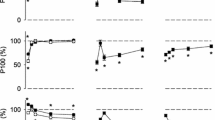Abstract
The power–inertial load relationship of the lower limb muscles was studied during a single leg thrust using the Modified Nottingham Power Rig (mNPR) and during cycling exercise in nine young male subjects. The relationship between peak power and inertial load showed a parabolic-like relationship for mNPR exertions, with a peak [937 (SD 246) W] at 0.158 kg m2, this being significantly (P <0.05) different from the power generated at both the lowest [723 (162) W] and highest [756 (206) W] inertial loads. In contrast, for cycling exercise power output did not differ significantly between inertial loads, except at the lowest inertia where power output was significantly (P<0.05) less compared with all other inertial loads. Maximum peak power output during cycling was 1,620 (336) W, which was significantly (P <0.05) greater than that recorded on the mNPR. However, a close association was observed between the mean power generated by each method (r=0.84, P<0.05). The results suggest that during a single contraction a range of inertial loads is required to allow peak power to be expressed. Above a certain critical value, this is unnecessary during cycling movements where the load can be repeatedly accelerated.








Similar content being viewed by others
References
Aagaard P, Simonsen EB, Trolle M, Bangsbo J, Klausen K (1994) Moment and power generation during maximal knee extensions performed at high and low speeds. Eur J Appl Physiol 69:376–381
Baker J, Gal J, Davies B, Bailey D, Morgan R (2001) Power output of legs during high intensity cycle ergometry: influence of handgrip. J Sci Med Sport 4:10–18
Baron R, Bachl N, Petschnig R, Tschan H, Smekal G, Pokan R (1999) Measurement of maximal power output in isokinetic and non-isokinetic cycling: a comparison of two methods. Int J Sports Med 20:532–537
Bassey EJ, Short AH (1990) A new method for measuring power output in a single leg extension: feasibility, reliability and validity. Eur J Appl Physiol 60:385–390
Bobbert MF, Gerritsen KG, Litjens MC, Van Soest AJ (1996) Why is countermovement jump height greater than squat jump height? Med Sci Sports Exerc 28:1402–1412
Capmal S, Vandewalle H (1997) Torque-velocity relationship during cycle ergometer sprints with and without toe clips. Eur J Appl Physiol Occup Physiol 76:375–379
Davies CT, Young K (1983) Effect of temperature on the contractile properties and muscle power of triceps surae in humans. J Appl Physiol 55:191–195
Dietz V, Noth J (1978) Spinal stretch reflexes of triceps surae in active and passive movements (proceedings). J Physiol (Lond) 284:180P-181P
Faria IE, Cavanaugh PR (1978) The physiology and biomechanics of cycling. Wiley, New York
Hawkins D, Hull ML (1990) A method for determining lower extremity muscle-tendon lengths during flexion/extension movements. J Biomech 23 487–494
Hill AV (1938) The heat of shortening and the dynamic constants of muscle. Proc R Soc Lond Ser B126:136–195
Martin JC, Wagner BM, Coyle EF (1997) Inertial-load method determines maximal cycling power in as single exercise bout. Med Sci Sports Exerc 29:1505–1512
Martin JC, Diedrich D, Coyle EF (2000) Timecourse of learning to produce maximum cycling power. Int J Sports Med 21:485–487
McCartney N, Heigenhauser GJ, Jones NL (1983) Power output and fatigue of human muscle in maximal cycling exercise. J Appl Physiol 55:218–224
Pearson SJ, Harridge SD, Grieve DW, Young A, Woledge RC (2001) A variable inertial system for measuring the contractile properties of human muscle. Med Sci Sport Exerc 33:2072–2076
Sargeant AJ (1987) Effect of muscle temperature on leg extension force and short term power output in humans. Eur J Appl Physiol Occup Physiol 56:693–698
Sargeant AJ, Hoinville E, Young A (1981) Maximum leg force and power output during short term dynamic exercise. J Appl Physiol 51:1175–1182
Svantesson U, Ernstoff B, Bergh P, Grimby G (1991) Use of a Kin Com dynamometer to study the stretch shortening cycle during plantar flexion. Eur J Appl Physiol Occup Physiol 62:415–419
Acknowledgements
This work was supported by the Wellcome Trust: The technical assistance of Alan Snook, Phil Oliver and Apostolos Galantis is gratefully acknowledged. All work carried out complies with the law of the UK.
Author information
Authors and Affiliations
Corresponding author
Appendix
Appendix
Polynomial fitting
In order to determine power output, a second-order polynomial (mNPR) and third-order polynomial (Cycle) were fitted to the power velocity data. These specific polynomials were chosen based on the best fit to the data (r 2 value). The differentiated equation was then used in order to calculate the maximal velocity and subsequent power.
Linear torque–velocity relationship
From the torque–velocity relationship shown in Fig. 5 the equation of the line can be represented by: T=−a×v+b. Where T is instantaneous torque, v is instantaneous velocity and both a and b are constants. Power can then be calculated as the product of torque and velocity which, if the above equation is substituted for torque, yields: P=av 2 +bv. Thus maximal power will be achieved when the gradient of the power curve is zero, i.e. when 2×a×v+b=0. From this formula it can be seen that the velocity at peak power (v opt) is \( \raise0.7ex\hbox{${ - b}$} \!\mathord{\left/ {\vphantom {{ - b} {2 \times a}}}\right.\kern-\nulldelimiterspace} \!\lower0.7ex\hbox{${2 \times a}$}. \) Knowing that torque is zero at v max, v max can be written as 0=a×v max+b. v max is therefore –b/a, half this value equates to \( \raise0.7ex\hbox{${ - b}$} \!\mathord{\left/ {\vphantom {{ - b} {2 \times a}}}\right.\kern-\nulldelimiterspace} \!\lower0.7ex\hbox{${2 \times a}$} \) or v opt.
Rights and permissions
About this article
Cite this article
Pearson, S.J., Cobbold, M. & Harridge, S.D.R. Power output of the lower limb during variable inertial loading: a comparison between methods using single and repeated contractions. Eur J Appl Physiol 92, 176–181 (2004). https://doi.org/10.1007/s00421-004-1046-0
Accepted:
Published:
Issue Date:
DOI: https://doi.org/10.1007/s00421-004-1046-0




